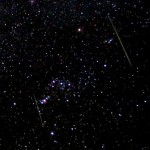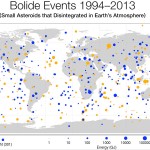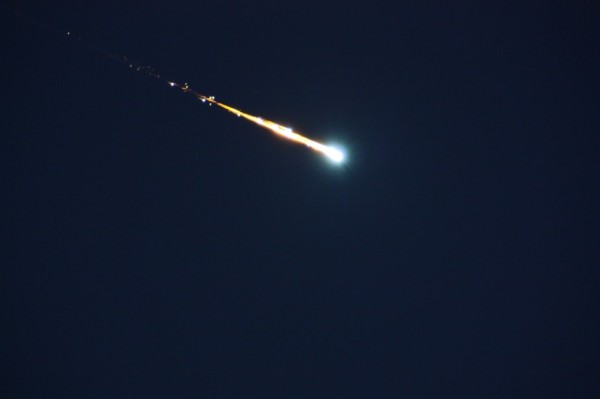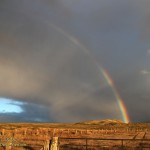A reminder that tonight is the peak of the Geminid meteor shower. Meteors will begin to appear around 8pm when the constellation Gemini and the radiant rises. The peak occurs at 8am on the 14th, favoring the early morning hours. As the Geminid meteors have a broad peak activity can be expected to be good all night long.
Category: Meteor Showers
Wish upon a falling star
Geminid Meteor Shower
The annual Geminid meteor shower is one of the most reliable annual meteor showers. The shower is noted for a steady stream of bright meteors with rates of well over 100 per hour.

The shower peak is predicted for December 14th, at around 18:00UT (14Dec 08:00HST). For viewers in the central Pacific this favors the evening of Dec 13th into the morning of Dec 14th, starting around 8pm as Gemini rises in the east. The peak is broad, with near peak rates occurring a day either side of the maximum, thus allowing everyone with a dark sky to enjoy this event. Thus the evening of the 14th may also provide a good viewing opportunity.
Even from more southerly sites, this is an excellent stream of often bright, medium-speed meteors, a rewarding event for all observers, whatever method they employ. The peak has shown slight signs of variability in its rates and timing in recent years, with the more reliably-reported maxima during the past two decades (HMO, p. 171) all having occurred within λ⊙ = 261.5° to 262.4°, 2015 December 14, 01h30m–23h UT. Near-peak Geminid rates usually persist for almost a day though, so much of the world has the chance to enjoy something of the shower’s best, regardless of when the maximum actually happens. Mass-sorting within the stream means fainter telescopic meteors should be most abundant almost a day ahead of the visual maximum, with telescopic results indicating such meteors radiate from an elongated region, perhaps with three sub-centres. Further results on this topic would be useful. The 2015 peak arrives just three days after new Moon, so observing conditions are ideal. – IMO 2015 Meteor Calendar
As noted by the IMO calendar entry above, new Moon will be on the 11th, placing the peak just a few days after new, a thin crescent in the evening sky that will set early. This leaves a perfect dark sky to enjoy the meteor shower. In the islands Gemini will rise around 8pm, bringing the constellation Gemini and the shower radiant over the horizon and marking the start of the show.
Watching meteors requires no more equipment than your eyes and a dark sky, and can be enjoyable for just about anyone.
Perseid Meteor Shower
Over the next few days the Perseid meteor shower will peak. As the most reliable shower each year this is also the most viewed meteor shower. Plentiful shooting stars combined with warm summer evenings makes this shower the easiest and most comfortable to view across much of the northern hemisphere. Quite a difference from the other reliable showers such as the Leonids and Quadrantids, that occur in November and January. Consider a warm summer night under a dark sky full of stars, a picnic blanket, relaxing while shooting stars streak across the sky. What could be better?

Quadrantid Meteor Shower
The first meteor shower of 2015 is the annual Quadrantid meteor shower. The Quadrantids are a reliable shower, producing 60-120 ZHR, one to two meteors per minute. The Quadrantids are named for the obsolete constellation Quadrans Muralis, now part of the constellation Boötes.

Watching meteors requires no more equipment than your eyes and a dark sky, and can be enjoyable for just about anyone. Set the alarm early? Probably not this year.
Geminids and a Comet
Stayed up late tonight to check on a few things in the sky. Firstly the Geminid meteor shower, which is peaking nicely. At least 100ZHR and bright enough to be nicely visible, even against the light of a bright gibbous moon.
The second item I wanted to see was comet C/2014 Q2 Lovejoy, now climbing higher in the sky as it swings northwards. It is currently somewhat low in Puppis, but getting higher each night as it moves nearly due north against the constellations. Currently it is an easy binocular object at around 7th magnitude. A quick sweep with my 9×50’s picked it up without effort halfway between Adhara and Canopus.
It is forecast to reach around 5th magnitude over the next month. Peak magnitude should occur near the new year while the comet is in Lepus. We placed and quite bright, I will be arranging to get a few photos of this comet through the new year!
The Sky Is Falling
Yes… The sky is falling… Literally.
Anyone who spends a good amount of time observing the night sky is well aware of how common meteors are. On any given night you will see five to ten meteors an hour is you observe carefully from a dark site. This rate goes up dramatically during a meteor shower. Most of the meteors you will see are quite small, ranging from dust grains to smallish sand sized bits. Anything large can be quite spectacular. Something the size of a pebble will create a bright meteor, a bright fireball that streaks across the sky.

Estimates vary widely, but something like 50,000 tons of meteoric material rains down on the Earth every year. The process that allowed our planet to form continues to this day.
Occasionally a larger object enters the atmosphere. Something big enough to reach the ground intact. Or even something big enough to cause damage from the impact. How often this occurs would be a surprise to most of our fellow citizens who pay little attention to the the natural world around them.
The Chelyabinsk event got the world’s attention. A medium sized object exploded in the atmosphere directly over a mid-sized city causing modest damage. Due to the prevalence of camera gear in modern Russia we were treated to an unprecedented view of this event. With historical events like Tunguska, all we have is eyewitness accounts and a few grainy black and white photographs of the damage taken years after the impact. Now we get dozens of videos of the event that detail how it occurred from dozens of viewpoints.
While this event is unusual, it was not unprecedented, objects of this size will continue to impact our planet. Meanwhile the event fades from public awareness, at least until it happens again… Which it will.
To drive home this point researchers at NASA’s Near Earth Object (NEO) Program have released a map of impacts over the last few years. Using atmospheric sensors that detect the pressure wave of the airburst they were able to locate and estimate the size of the larger events. For further details you can read the press release.
The Chelyabinsk meteor can be seen as a large dot over southern Russia. That event may be the largest dot on the map, but it is not alone. It is the number of other dots that may surprise some people. Our planet is impacted regularly.

Leonid Meteor Shower
The Leonids are one of the better known annual meteor showers. Some years see high Leonid activity, with amazing numbers of meteors. This shower has occasionally created true meteor storms. Unfortunately 2014 is not predicted to be one of those years, with very modest numbers expected.

Due to the gravitational influence of Jupiter, the Leonids are not expected to produce any exceptional showers for some decades. We are unlikely to see any repeats of the early 21st century storms anytime soon.
Comet 209P LINEAR Meteor Shower Reminder
A reminder that there is the possibility of a strong meteor shower this evening. The Earth may pass through a cloud of debris left by comet 209P/LINEAR. Sky watchers should observe around 21:00 to 22:00HST on the evening of May 23rd.

For Hawai’i the radiant will be low in the north, about 20 degrees above the horizon, near Polaris. This means that any meteors we see will be hitting the atmosphere at a low angle. Combined with the low speed of the meteors this could lead to very showy bolides streaking across much of the sky.
As with any meteor shower, any predictions are to be taken with a large dose of skepticism. It is important to point out that meteor prediction is not an exact science, rather a bit of an art form. In this case there are any number of unknowns involved, we could see nothing, we could see a true meteor storm. This event could be anything from “meh” to “oh wow!!!”. To their credit, the folks making these predictions have been impressively right on several recent showers.
I would strongly suggest that you at least take an effort to step outside after 9pm on Friday evening and see what the sky has to offer. All you need is a clear dark sky.
A Different Meteor Shower
The meteor wildcard of 2014 is something new. Several meteor experts are predicting a possible shower from comet 209P/LINEAR. The Earth will pass close to the debris stream from this comet in late May this year, possibly creating a decent meteor shower, or even a meteor storm.

Of greatest potential significance this quarter, indeed this year, is an encounter between the Earth and a number of dust trails left by Comet 209P/LINEAR at its perihelion returns within twenty years to either side of 1900 AD. Several predictions have already been issued for what may occur, and further updates are likely nearer the event. Based on the most recent independent calculations by Esko Lyytinen, Mikhail Maslov and J´er´emie Vaubaillon, the strongest activity from this source should happen on May 24, most likely between about 07h to 08h UT from a radiant near the borders of Lynx, Ursa Major and Camelopardalis, quite close to o UMa. The predicted radiant locations fall within a few degrees of α = 124° , δ = +79° . Timings in UT for the centre of the strongest activity overall are around 07h 03m (Lyytinen), 07h 21m (Maslov) and 07h 40m (Vaubaillon) respectively.
However, much is unknown about this comet, including its dust productivity and even its precise orbit. Consequently, while tentative proposals have been made that ZHRs at best could reach 100+, perhaps up to storm proportions, based purely on the relative approach distances between the Earth and the computed dust trails, these are far from certain. The strongest activity could be short lived too, lasting perhaps between a few minutes to a fraction of an hour only. In addition, the number of dust trails involved means there may be more than one peak, and that others could happen outside the “key hour” period, so observers at suitable locations are urged to be vigilant for as long as possible to either side of the predicted event to record whatever takes place.
Remember, there are no guarantees in meteor astronomy! Lunar observing circumstances are very positive, with May’s new Moon on the 28th. The north-circumpolar radiant area for many sites means the three main geographic zones where most radio observers are located – Europe, North America and Japan – should be able to follow all that occurs, interference permitting. The time of year means the northern nights are close to their shortest for visual and imaging work, but the predicted strongest activity timings fall perfectly for night-time coverage all across North America and the nearby oceans to its east and west.
–IMO Website 2014 Calendar
The takeaway from what we know… This shower is highly uncertain, we could get anything from nothing to meteor storm. The peak will be short and sharp, lasting only a few hours. With a peak near 07:00-08:00hUT on May 24th, observers in the Pacific should be alert from 21:00 to 22:00HST on the evening of the 23rd. New Moon occurs on the 28th, indicating there should be no moonlight to contend with.
Naked Eye 100 Challenge
Amateur astronomers love lists… The Messier observing list, the Hershel 400, the Hershel II, and on. Some lists can be complete on a night or two, some lists may take years, or even a lifetime to accomplish. Amateur astronomy is not the only avocation to use lists like this. Birders attempt to see all of the birds known to occur in their home country. Aircraft spotters love to see each model of aircraft in the air. Divers keep lists of species seen underwater.

Most of the astronomy observing lists require a small telescope to accomplish, or at least a pair of binoculars. One list is a bit different, it does not require any optical aid at all… The Naked Eye 100.
